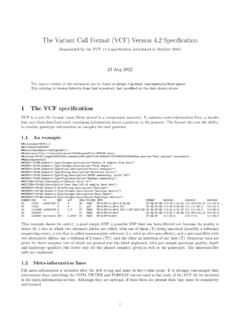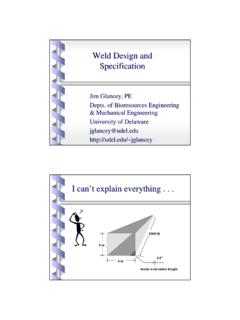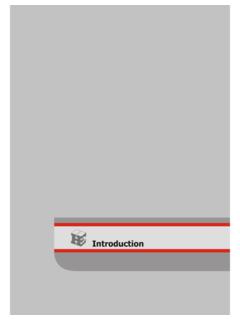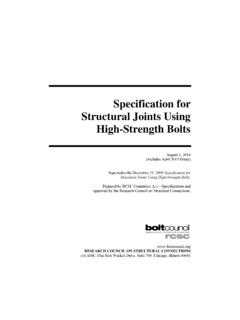Transcription of Sequence Alignment/Map Format Specification
1 Sequence Alignment/Map Format SpecificationThe SAM/BAM Format Specification Working Group22 May 2018 The master version of this document can be found printing is version b1ae9f9 from that repository, last modified on the date shown The SAM Format SpecificationSAM stands for Sequence Alignment/Map Format . It is a TAB-delimited text Format consisting of a headersection, which is optional, and an alignment section. If present, the header must be prior to the lines start with @ , while alignment lines do not. Each alignment line has 11 mandatory fields foressential alignment information such as mapping position, and variable number of optional fields for flexibleor aligner specific Specification is for version of the SAM and BAM formats.
2 Each SAM and BAM file mayoptionally specify the version being used via the@HD VNtag. For full version history see Appendix explicitly specified elsewhere, all fields are encoded using 7-bit US-ASCII1in using the POSIX /C locale. Regular expressions listed use the POSIX / IEEE Std extended An exampleSuppose we have the following alignment with bases in lower cases clipped from the alignment. Readr001/1andr001/2constitute a read pair;r003is a chimeric read;r004represents a split 12345678901234 5678901234567890123456789012345ref AGCATGTTAGATAA**GATAGCTGTGCTAGTAGGCAGTCA GCGCCAT+r001/1 TTAGATAAAGGATA*CTG+r002 aaaAGATAA*GGATA+r003 gcctaAGCTAA+r004 ttagctTAGGC-r001/2 CAGCGGCATThe corresponding SAM Format is:21 Charset as defined in values in theFLAG column correspond to bitwise flags as follows: 99 = 0x63: first/next is reverse-complemented/properly aligned/multiple segments.
3 0: no flags set, thus a mapped single segment; 2064 = 0x810: supplementary/reverse-complemented; 147 = 0x93: last (second of a pair)/reverse-complemented/properly aligned/multiple @HD SO:coordinate@SQ SN:ref LN:45r001 99 ref 7 30 8M2I4M1D3M = 37 39 TTAGATAAAGGATACTG *r002 0 ref 9 30 3S6M1P1I4M * 0 0 AAAAGATAAGGATA *r003 0 ref 9 30 5S6M * 0 0 GCCTAAGCTAA * SA:Z:ref,29,-,6H5M,17,0;r004 0 ref 16 30 6M14N5M * 0 0 ATAGCTTCAGC *r003 2064 ref 29 17 6H5M * 0 0 TAGGC * SA:Z:ref,9,+,5S6M,30,1;r001 147 ref 37 30 9M = 7 -39 CAGCGGCAT * NM: Terminologies and ConceptsTemplateA DNA/RNA Sequence part of which is sequenced on a sequencing machine or assembled fromraw contiguous Sequence or raw Sequence that comes off a sequencing machine.
4 A read may consist of multiple segments. Forsequencing data, reads are indexed by the order in which they are alignmentAn alignment of a read to a single reference Sequence that may include insertions,deletions, skips and clipping, but may not include direction changes ( one portion of the alignmenton forward strand and another portion of alignment on reverse strand). A linear alignment can berepresented in a single SAM alignmentAn alignment of a read that cannot be represented as a linear alignment. A chimericalignment is represented as a set of linear alignments that do not have large overlaps.
5 Typically, oneof the linear alignments in a chimeric alignment is considered the representative alignment, and theothers are called supplementary and are distinguished by the supplementary alignment flag. All theSAM records in a chimeric alignment have the sameQNAMEand the same values for 0x40 and 0x80flags (see Section ). The decision regarding which linear alignment is representative is alignmentA linear alignment or a chimeric alignment that is the complete representation of thealignment of the mappingThe correct placement of a read may be ambiguous, due to repeats.
6 In thiscase, there may be multiple read alignments for the same read. One of these alignments is consideredprimary. All the other alignments have the secondary alignment flag set in the SAM records thatrepresent them. All the SAM records have the sameQNAMEand the same values for 0x40 and 0x80flags. Typically the alignment designated primary is the best alignment, but the decision may coordinate systemA coordinate system where the first base of a Sequence is one. In this co-ordinate system, a region is specified by a closed interval. For example, the region between the 3rdand the 7th bases inclusive is [3,7].
7 The SAM, VCF, GFF and Wiggle formats are using the 1-basedcoordinate coordinate systemA coordinate system where the first base of a Sequence is zero. In thiscoordinate system, a region is specified by a half-closed-half-open interval. For example, the regionbetween the 3rd and the 7th bases inclusive is [2,7). The BAM, BCFv2, BED, and PSL formats areusing the 0-based coordinate scaleGiven a probability 0< p 1, the phred scale ofpequals 10 log10p, rounded to the chimeric alignment is primarily caused by structural variations, gene fusions, misassemblies, RNA-seq or The header sectionEach header line begins with the character @ followed by one of the two-letter header record type codesdefined in this section.]
8 In the header, each line is TAB-delimited and, apart from@COlines, each data fieldfollows a Format TAG:VALUE whereTAGis a two-character string that defines the Format and content ofVALUE. Thus header lines match/^@[A-Z][A-Z](\t[A-Za-z][A-Za-z0-9] :[ following table describes the header record types that may be used and their predefined tags. Tagslisted with * are required; , every@SQheader line must haveSNandLNfields. As with alignment optionalfields (see Section ), you can freely add new tags for further data fields. Tags containing lowercase lettersare reserved for local use and will not be formally defined in any future version of this @HDThe header line.)]
9 The first line if * Format Format :/^[0-9]+\.[0-9]+$/.SOSorting order of values:unknown(default),unsorted,queryna meandcoordinate. For coordinate sort, the major sort key is theRNAME field, with order definedby the order of@SQlines in the header. The minor sort key is thePOSfield. For alignmentswith equalRNAMEandPOS, order is arbitrary. All alignments with * inRNAME field followalignments with some other value but otherwise are in arbitrary of alignments, indicating that similar alignment records are grouped together but thefile is not necessarily sorted values:none(default),query(alignments are groupedbyQNAME), andreference(alignments are grouped byRNAME/POS).
10 @SQReference Sequence dictionary. The order of@SQlines defines the alignment sorting *Reference Sequence name. TheSNtags and all individualANnames in all@SQlines must bedistinct. The value of this field is used in the alignment records expression:[!-)+-<>-~][!-~]*LN*Reference Sequence :[1,231-1]AHIndicates that this Sequence is an alternate value is the locus in the primary assemblyfor which this Sequence is an alternative, in the Format chr:start-end , chr (if known), or * (ifunknown), where chr is a Sequence in the primary assembly. Must not be present on sequencesin the primary reference Sequence comma-separated list of alternative names thattools may use when referring to this reference alternative names arenot used elsewhere within the SAM file; in particular, they must not appear in align-ment records expression:name(,name)*wherenameis[0-9A- Za-z][0-9A-Za-z*+.]












